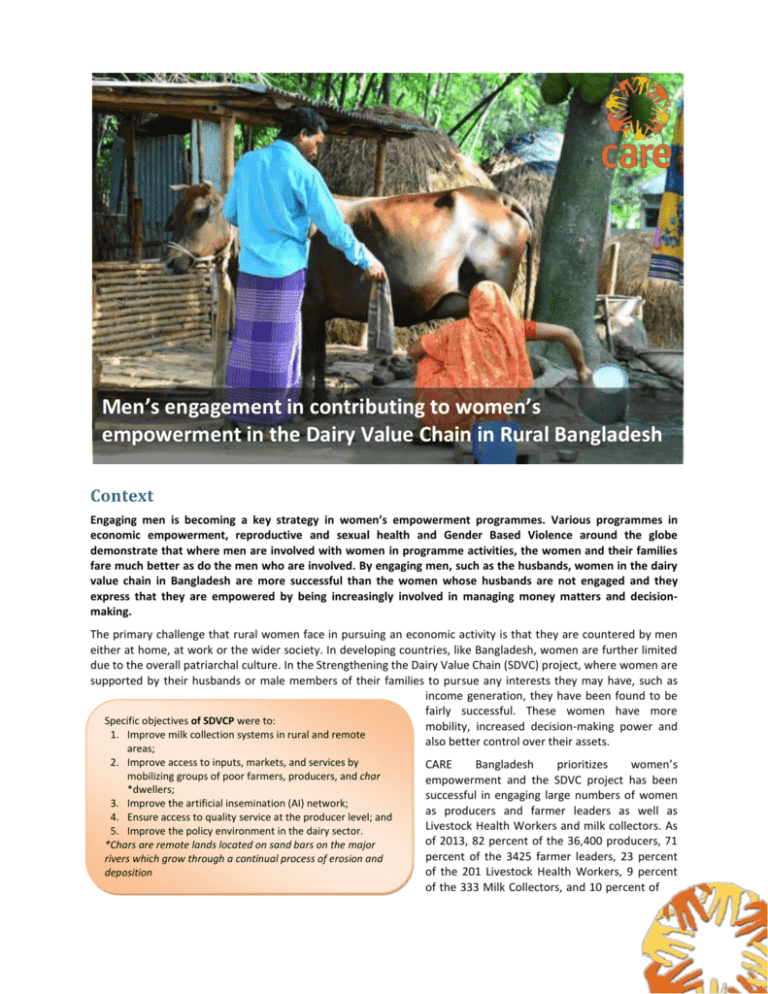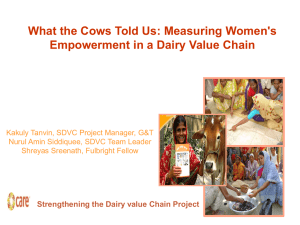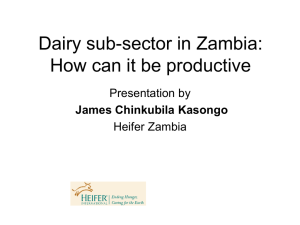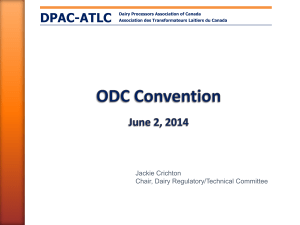Innovation Brief 4 - Economic Development Unit
advertisement

Men’s engagement in contributing to women’s empowerment in the Dairy Value Chain in Rural Bangladesh Context Engaging men is becoming a key strategy in women’s empowerment programmes. Various programmes in economic empowerment, reproductive and sexual health and Gender Based Violence around the globe demonstrate that where men are involved with women in programme activities, the women and their families fare much better as do the men who are involved. By engaging men, such as the husbands, women in the dairy value chain in Bangladesh are more successful than the women whose husbands are not engaged and they express that they are empowered by being increasingly involved in managing money matters and decisionmaking. The primary challenge that rural women face in pursuing an economic activity is that they are countered by men either at home, at work or the wider society. In developing countries, like Bangladesh, women are further limited due to the overall patriarchal culture. In the Strengthening the Dairy Value Chain (SDVC) project, where women are supported by their husbands or male members of their families to pursue any interests they may have, such as income generation, they have been found to be fairly successful. These women have more Specific objectives of SDVCP were to: mobility, increased decision-making power and 1. Improve milk collection systems in rural and remote also better control over their assets. areas; 2. Improve access to inputs, markets, and services by mobilizing groups of poor farmers, producers, and char *dwellers; 3. Improve the artificial insemination (AI) network; 4. Ensure access to quality service at the producer level; and 5. Improve the policy environment in the dairy sector. *Chars are remote lands located on sand bars on the major rivers which grow through a continual process of erosion and deposition CARE Bangladesh prioritizes women’s empowerment and the SDVC project has been successful in engaging large numbers of women as producers and farmer leaders as well as Livestock Health Workers and milk collectors. As of 2013, 82 percent of the 36,400 producers, 71 percent of the 3425 farmer leaders, 23 percent of the 201 Livestock Health Workers, 9 percent of the 333 Milk Collectors, and 10 percent of the 52 Artificial Inseminator Workers are women. It has been found that the support of men for women and thus inclusion of men is a very important factor for a successful women’s empowerment program. Background to the SDVC project: CARE identified that dairy farming which is a traditional occupation of rural homesteads and is often managed by women, as a feasible pathway to engaging women more intensively in household decision-making processes. Their participation in the dairy sector was perceived to be critical in increasing their incomes and improving their status at the household level and within the community. However, the dairy farming sector in Bangladesh, particularly in the North and Northwest regions, faces many challenges that impede on the level of success that dairy farmers can achieve. Poor cattle breeds, low milk yields compounded further by inadequate infrastructure and a complex array of challenges in the input supply and service provision for poor smallholders all reduce the profit that farmers are able to generate from their milk sales. CARE, through the SDVC project, sought to improve the dairy farming sector while enabling and promoting women’s empowerment through intensive engagement in the dairy value chain and by increasing diversifying the roles they can take on within the dairy sector. With funding support from the Bill and Melinda Gates Foundation, CARE implemented the Strengthening the Dairy Value Chain Project in nine districts in Northwestern Bangladesh from October 2007 to December 2012. The project aimed to increase the income of 35,000 targeted smallholder and landless milk producer households, and to create employment opportunities for extremely poor households—especially for women—through various activities throughout the dairy value chain The SDVC project took every stage of the value chain into consideration. The project mobilized smallholders into producer groups and gave them training on livestock health, the benefits of cross-bred cows and the use of artificial insemination, feeding practices and financial management. 82% of the producers were women and through various project activities, many of these women have been able to bring about a positive change in their status as cattle owners and as decision-makers with regards to their own incomes and household assets. However, the path to this achievement was not as straightforward as the project had thought. Training female producers and enabling linkages with other value chain actors to be able to pursue improved dairy activities did not necessarily put women in an empowered position with regards to the different facets of income control, decision-making and control over assets. Initially, the introduction of improved dairy practices cause the workload of the women to increased while their overall role in decision-making and control of assets remained unchanged. In order to better measure and track the impact of the project on gender and asset ownership, in 2010 SDVC sought a partnership with the GAAP project, which is jointly implemented by IFPRI-ILRI (International Food Policy Research Institute (IFPRI) and the International Livestock Research Institute (ILRI))1. Over a period of 38 months (April 2010-June 2013), the GAAP project facilitated different research initiatives and quantitativequalitative tools were developed and utilized Women’s position in rural Bangladesh Bangladeshi women have limited control over the income earned from their labor, and very little access to procure and control assets. Women’s mobility is limited because of traditional patriarchal attitudes and therefore are secluded to the home and limited in their role in the dairy value chain, mainly as producers. Women can own productive assets such as livestock and poultry if bought with their own money or as gift from parents; however they may or may not have decisionmaking power over these assets. Women are responsible for care of livestock and dairy care and production, however there are no formal livestock property rights in Bangladesh and women owning cattle can still be at a disadvantage when ownership of cattle is challenged. Women are overburdened with domestic and homestead 1 http://gaap.ifpri.info/; http://www.ilri.org/node/1193 labor as well as unequal division of labor limiting their mobility outside the home. to measure the impact on women’s empowerment in the SDVC project. It is through these tools and regular project observations that CARE was able to determined how to best engage men in project activities. It was found that when men were engaged in project activities, women perceived a positive change in their behavior towards them. There were some cases where men were already demonstrating positive attitudes towards women’s empowerment as opposed to Bangladesh’s traditional patriarchal norms. These men encouraged their wives to take increasing responsibility for income generation, utilization and decision-making. These men were drawn on to demonstrate positive behavior and as role models/change-makers for other men in their communities. The SDVC has taken some steps to include men in project activities. For the selection process of beneficiaries, men from the communities were included in CARE’s decision-making process (value chain stakeholders/service providers and influential community people) to discuss who should be included and why. Since men have a significant role in reducing the obstacles faced by women, men have been encouraged to attend project sessions on gender awareness. Community based workshops served to sensitize community people (local influential people and dairy service providers) about women’s contribution to the dairy value chain and the need for them to be supported without obstacles. The workshops participants discussed the obstacles faced by women and their role in reducing these. Nurjahan is the team leader and also milk collector for her group. According to Nurjahan, her husband is more sensitive than most husbands. He was the one who pushed her to attend the group meetings while he took care of the household work. He would ask about what she learnt at the meetings which gave her a feeling of confidence “I never thought that an illiterate person like me could teach anyone anything; my husband allows me to go where I need to go for my work – to the bazaar or the bank. Just because of the way my husband supports me and has given me freedom in my work, I am respected much more among my family members and in the community – I have learn how to negotiate and deal with different kinds of people and have grown to become a more confident person which would not have been possible with my husband’s support”. Mohaiminul, a businessman (35), joined his wife, Rebeka’s producer group because it was thought that he would be able to convince the husbands’ of the other women producers to let their wives attend training and group meetings. Mohaiminul talks about how SDVC has helped him “It’s true that CARE does not financially help me but they have helped me learn new things. I now have a sufficient supply of cattle fodder and the rest I can sell and earn good money; By being in the group and through attending group meetings, I know it is important for men and women to work together, and so even when I cannot attend, I make sure that my wife attends the group meetings by helping with the housework. Working together with his wife helps their milk collection business, so she can take care of it when he out of the village on other business. My wife takes care of how to utilize the income from milk sales”. Rebeka confirms her husband’s support, “My husband supports me to do all my works, otherwise would not have been a member of our producer group.” Then there are the men who have changed as a result of participating in the project activities. This change was more obvious in regions where project engaged men and women together in group discussions to assess barriers faced by women at home and in the dairy value chain, division of labor and look at community dynamics and contribution of women to family income. The women report that in participating in these exercises, the men have become more understanding of the women’s role in the dairy value chain and especially supportive of women by easing their workload. Women also have more freedom and mobility in pursuing their income generating activities. Beauty (40) is a fairly successful dairy farmer after learning improved dairy practices from SDVC. She contributes considerably to the family income. She has saved money to buy four decimals of land and built a house in her name. Her husband, who was a local van driver, did not earn enough to send their two sons to school. The children now go to school. Beauty says this would not have been possible without her husband’s support “my husband is more intent than me that I participate in the training session regularly and he doesn’t have any questions about how I wish to spend the money”. Rehana (35) has seven cows and dairying is her family tradition. Her husband is a farmer and is busy with his own business. Even though her husband does not help her with dairy work, he is supportive and lets her control the income from the dairy. She says, “my husband does not help me in dairy related work, but he is supporting me in what I am doing, he has no problem with that”. Morzina never went school but she has a literate husband who helps her and makes her work easier. They have joint ownership of six cows but Morzina makes most of the dairy-care related decision, e.g. time to give vaccination, what crossbreeds to buy. Looking ahead The project recognizes that it has to intensify its activities to improve gender dynamics and a way to do this is by increasing its efforts around further sensitizing men about women’s potential to thrive in the dairy value chain. However, first an in-depth exercise is required to assess what motivates men to be supportive of women’s activities and their role at home and in the community. Also, further research must be done to understand what specific activities, in addition to the discussion exercises used by SDVC, can be used to engage men further in SDVC project activities to support women. Increasing men’s support for women’s engagement in livestock management and dairy value chain activities is critical to women’s overall empowerment. Without men’s support and a positive change in their attitudes, collective progress of women as producers and decision-makers will be hampered. Photo Credits: Learn more about SDVC To learn more about our work, see resources at http://edu.care.org SDVC Project Summary Innovation Briefs Building Trust, Accountability and Performance: The BangladeshParticipatory Performance Tracking Matrix Commercializing Dairy Inputs through the Rural Sales Program References CARE – SDVC Project Documents





